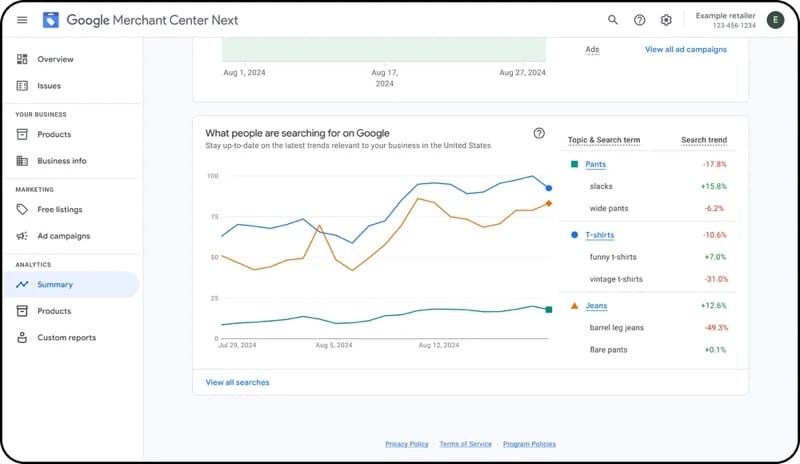TRD Issue 90 - Briefing: Meta AI Surges to 400M Users, Walmart's Bold Amazon Challenge
Meta AI reaches 400M users, Walmart expands the marketplace with Premium Beauty, and Temu faces headwinds. Plus, retail media networks are under fire for strong-arm tactics.

Hello Subscribers,
Have you noticed how quickly the retail tech landscape is transforming? Just when you think the dust has settled, another seismic shift occurs.
This week's developments show us exactly how the biggest players are jockeying for position in ways that will impact brands and consumers alike.
Today's featured stories examine Meta's surprisingly successful AI assistant challenging ChatGPT, Walmart's aggressive marketplace expansion, and troubling allegations about strong-arm tactics in retail media. All this while smaller players scramble to adapt or face irrelevance.
Today we look at:
- Meta AI reaching 400M monthly users in its battle against ChatGPT
- Why home robots still disappoint consumers despite decades of promises
- Walmart is building an Amazon competitor with Premium Beauty and enhanced logistics
- Temu's growth is hitting obstacles despite its meteoric rise
- Fashion brands pivoting back to in-person events (63% increasing investment)
- An agency CEO's revealing confession about retail media network kickbacks
- Small retail media networks struggling despite flashy upgrades
- Google's new shopping trend tools arriving just in time for holiday planning
- The potential $50B takeover that could transform Japanese corporate culture
The competitive landscape is heating up on all fronts. Let's unpack what it means for your business strategy going forward.
Happy reading!
The Retail Direct
About 91APP
Founded in 2013, 91APP is the premier OMO (online-merge-offline) SaaS company, providing one-stop omnichannel retail solutions in Taiwan, Hong Kong, and Malaysia. It offers advanced Commerce Solutions and Marketing Solutions that enable retail brands to penetrate the D2C (Direct-to-Consumer) e-commerce market and drive operational benefits to their full potential. In 2021, 91APP became the first SaaS company to be listed in Taiwan and has been named one of Taiwan's "NEXT BIG" companies by Startup Island TAIWAN.
For more information about 91APP (TWO: 6741), visit 91app.com.
AI
Meta's AI Grabs 400M Users, Challenges ChatGPT

Meta AI reached 400 million monthly and 40 million daily users in early August, less than a year after its launch. Zuckerberg confirmed these numbers on Threads, noting the service hasn't yet expanded to the UK, Brazil, or EU markets.
Why it matters: Meta's ability to leverage its 3 billion-user base gives it a substantial advantage in the AI assistant race, potentially disrupting OpenAI's early market dominance without charging subscription fees.
The competitive landscape:
- ChatGPT reports 200 million weekly users
- ChatGPT generates approximately $2B annually from subscriptions
- Meta AI remains free as part of Meta's broader AI investment strategy
The challenges:
- Only 10% of monthly users engage daily (compared to 80% for Meta's core apps)
- User complaints about aggressive in-app promotion
- Internal concerns about accidental or unintentional usage
The bottom line: Meta has already adjusted its interface after data showed roughly half of the users who opened the assistant quickly abandoned it – suggesting they were seeking search functionality, not AI assistance.
Source: The Information
ChatGPT Doubles to 200M Weekly Users, Leading AI Race

ChatGPT has doubled its user base to 200 million weekly active users since November 2023, OpenAI announced Thursday. The company also revealed that 92% of Fortune 500 companies now use its products.
Why it matters: Despite intense competition, OpenAI's ChatGPT maintains market leadership with explosive growth, proving consumer appetite for AI assistants while competitors scramble to catch up.
The competitive landscape:
- Meta recently reported 500 million monthly users for Meta AI
- Microsoft, Google, and Meta continue aggressive updates to capture market share
- Usage of OpenAI's automated API has doubled since the July 2024 release of the GPT-4o mini
CEO Sam Altman said in a statement: "People are using our tools now as a part of their daily lives, making a real difference in areas like healthcare and education."
Meta also announced significant growth for its open-source Llama models, with usage on major cloud services doubling between May and July following the Llama 3.1 release.
Source: Axios
Home Robots Still Fall Short Despite 62 Years of Promises

Despite iRobot selling over 50 million Roombas, today's home robots remain far from the versatile vision of "The Jetsons" Rosey character introduced 62 years ago. The successful home robots have focused on singular, specific tasks.
Why it matters: The gap between consumer expectations and robot reality remains substantial - even with tech giants like Amazon and Apple investing heavily, creating truly useful home robots faces fundamental challenges of price, functionality, and reliability.
What's working:
- Robot vacuums have found success by focusing on one task
- Lawnmowers and pool cleaners follow the same single-purpose model
- Navigation and mapping technologies continue to advance
The key challenges:
- Multifunctional robots become exponentially more complex and expensive
- Dynamic home environments require sophisticated sensing and AI
- Even tech giants struggle: Amazon's $1,600 Astro robot reportedly faltered
- Apple's rumored home robot may be scaled back to an iPad-like device on an arm
Home robot evolution is happening incrementally, with each innovation building on previous foundations. Experts suggest future success will come from robots designed for narrow applications in social interaction, caregiving, and simple household tasks.
Yes, but: Amazon maintains it's "still fully committed" to Astro and home robotics despite reports of the project's struggles.
Source: Tech Crunch
e-Commerce
Walmart Accelerates Marketplace Growth to Challenge Amazon

Walmart announced several marketplace enhancements at its seller summit, including Premium Beauty brands, expanded resale offerings, and improved logistics capabilities. The retailer's e-commerce business is expected to be profitable within two years after surpassing $100 billion in 2023 sales.
Why it matters: Walmart's aggressive expansion of its third-party marketplace signals its determination to close the e-commerce gap with Amazon by adopting similar strategies while leveraging its massive physical footprint as a competitive advantage.
By the numbers:
- Walmart Marketplace has grown over 30% in each of the past four quarters, with seller listings up 20% last fiscal year.
- The company's overall e-commerce business increased 22% in the U.S. last quarter, significantly outpacing Amazon's 5% growth.
Key marketplace initiatives:
- Premium Beauty launch with 20 high-end brands
- Expanded "Resold at Walmart" program with 5 million pre-owned items
- LocalFinds allows pickup/delivery directly from merchant stores
- Supply chain services to fulfill orders from any e-commerce site
- Direct transportation from Asia to Walmart warehouses
- Waived peak season storage fees for early holiday inventory
What people say: "Walmart is very much following the Amazon playbook of building a successful marketplace," said Sky Canaves, retail analyst at eMarketer.
Yes, but: Despite being the current beauty retail leader, Walmart faces pressure as Amazon is expected to overtake its beauty market position by 2025, according to Morgan Stanley.
Source: Modern Retail
Temu's Growth Slows as Amazon Challenge Loses Steam

Despite growing revenue by 86% to $13 billion in Q2, Temu's parent company, PDD Holdings, disappointed investors and lost $55 billion in market value. Company executives admitted that "high revenue growth is not sustainable and a downward trend in profitability inevitable."
Why it matters: Temu's quest to become an "Amazon killer" faces significant headwinds from regulatory scrutiny, expensive legal battles, and unsustainable economics, suggesting the e-commerce upstart may not pose the existential threat to Amazon once feared.
Key challenges:
- Regulatory pressure on the de minimis shipping exemption that enables Temu's low prices
- Legal battles with Shein costing potentially millions in litigation expenses
- Unsustainable marketing spend (up 1,000% year-over-year in 2023)
- Claims they lose approximately $30 on every sale
What people say: "They're still selling a lot of stuff to Americans. They should be very scary to any U.S. retailer," says Jason Goldberg, chief commerce strategy officer at Publicis Groupe.
Temu has made defensive moves by onboarding China-based sellers with U.S. warehouses since March 2024 to reduce reliance on direct shipping loopholes and improve delivery times.
Yes, but: Despite challenges, Temu remains formidable, with 28% of customers still purchasing 16 months after their first order – nearly double Walmart and Target's retention rates, though only half of Amazon's. Consumers perceive Temu as cheaper but Amazon as more convenient.
Source: Modern Retail
Retail
Couche-Tard's $50B 7-Eleven Bid Could Transform Japanese M&A

Canadian convenience store giant Alimentation Couche-Tard has approached 7-Eleven's parent company Seven & i Holdings with a friendly buyout bid that could exceed $50 billion. Though no formal proposal exists yet, the move has already sent shockwaves through Japan's business community.
Why it matters: The unsolicited takeover approach for Seven & i Holdings represents a watershed moment for Japan's corporate culture, potentially unleashing a wave of foreign acquisitions in a market that has historically resisted outside ownership.
Key deal elements:
- Canadian convenience store giant Couche-Tard makes friendly buyout bid
- The first major test of Japan's new shareholder-friendly M&A guidelines
- Could establish a precedent for how Japanese companies must respond to foreign takeover interest
- May trigger additional foreign bids for undervalued Japanese household names
By the numbers:
- Potential deal value exceeding $50 billion
- Seven & i deployed $25 billion in acquisitions with −1% shareholder returns
- Couche-Tard delivered 191% returns while deploying just $12 billion
- Seven & i trades at a significant conglomerate discount to its parts
Key challenges:
- Government concerns about foreign ownership of "lifeline infrastructure"
- Cultural questions about maintaining exceptional customer experience
- The fundamental tension between shareholder value and stakeholder interests
- Potential for "white knight" Japanese bidders to emerge
Yes, but: Despite obstacles, investors see transformative potential:
- Could spark a decade of M&A activity in Japan
- Would demonstrate the effectiveness of recent corporate governance reforms
- May unlock value in other underperforming Japanese conglomerates
What's next: All eyes are on Seven & i's response as Japanese corporations, investors, and regulators watch closely to see if this marks the beginning of a new era for Japanese business.
Source: FT
Fashion Brands Pivot to IRL Events, Deprioritize Out-of-Home Ads

63% of fashion brands surveyed by Modern Retail and Glossy plan to increase investment in IRL events this fall, making it their top marketing priority. This contrasts sharply with out-of-home advertising, which only 29% of brands prioritize.
Why it matters: As digital marketing costs rise and platform effectiveness becomes more unpredictable, fashion brands are rediscovering the value of real-world connections with customers through in-person events that create memorable experiences and drive engagement.
Marketing investment priorities:
- IRL events: 63% of brands increasing investment
- Print media (magazines/newspapers): 39%
- Direct mail: 37%
- Out-of-home advertising: 29% (represents just 2% of total industry ad spend)
On digital platforms:
- Instagram remains dominant, with 83% of surveyed brands having purchased ads there in the last month.
- However, only 1.4% reported spending on Instagram's sister platform Threads.
- TikTok shows mixed signals - while only 41% purchased TikTok ads recently, 55% plan to increase their presence on the platform, and 36% are selling via TikTok Shop.
- Pinterest is gaining traction, with approximately 20% of brands investing in Pinterest ads. The platform recently surpassed 500 million monthly active users and shows particular strength with Gen Z.
Yes, but: Despite premium positioning aspirations, most fashion brands rely on regular discounting, with 23% running promotions monthly and 18% offering 6-12 promotions annually. Only 16% of brands reported never offering discounts.
Source: Modern Retail
Marketing
Retail Media Networks Face Accusations of Strong-Arm Tactics

An anonymous agency CEO reveals that shelf space is increasingly tied to retail media network (RMN) spending, creating what they describe as "quid pro quo" arrangements that disadvantage smaller brands unable to afford the steep prices.
Why it matters: The booming retail media sector, projected to capture nearly 25% of US ad spend by 2028, faces serious transparency issues with allegations that retailers are forcing brands to buy expensive advertising or risk losing shelf space.
Key allegations:
- Retailers creating "quid pro quo" arrangements linking shelf placement to ad spending
- "If you're not paying this retail media network, you're not going to be on the shelf"
- Such practices are becoming "almost the standard" across the industry
- These tactics disproportionately disadvantage smaller brands
By the numbers:
- RMN CPMs exceeding $25, far higher than alternative targeting methods
- Agency workarounds can reduce targeting costs by 50% or more
- Retail media is expected to represent 25% of US ad spend by 2028
- More than 200 retail media networks are now competing for brand dollars
Agency workarounds:
- Combining retailer data with alternative, more affordable signals
- Focusing on broader indicators like store visits rather than specific product purchases
- Creating hybrid targeting approaches that maintain effectiveness at lower costs
- Developing alternative channels for smaller-budget clients
Yes, but: These solutions create tensions:
- Agencies financially incentivized to maximize media spending
- Alternative targeting conflicts with agency revenue models
- Many brands lack negotiating power against retail giants
What's next: Industry observers anticipate potential regulatory scrutiny if these practices continue to spread, while smaller brands may increasingly seek alternative routes to market that don't rely on major retailers' media networks.
Source: DigiDay
Small Retail Media Networks Struggle Despite Flashy Upgrades

Why it matters: As smaller retail media networks compete for limited ad dollars through rebrands and new features, media buyers remain focused on fundamentals—scale, data quality, and cross-channel measurement—making it increasingly difficult for niche players to compete with Amazon and Walmart.
Market landscape:
- More than 200 retail media networks are now operating
- Google's retention of third-party cookies hasn't slowed network expansion
- Retailers fighting for a portion of finite media budgets
- Amazon's ad business reaches $50 billion annually
Recent retailer moves:
- Lowe's rebranded from "One Roof Media Network" to "Lowe's Media Network"
- Macy's expanded its partnership with Rokt for new advertising use cases
- Home Depot rebranded with new in-store ad offerings
- Numerous specialty retailers are launching their own networks
What buyers actually want:
- Extensive first-party data ownership
- Cross-channel measurement capabilities
- Holistic view of shopper behavior
- Scale sufficient to justify the investment
Yes, but: Specialty networks still offer value through:
- Highly targeted, loyal audiences
- Niche category expertise
- Regional market penetration
- Category-specific insights
What's next: Industry consolidation is likely as buyers concentrate spending on networks that deliver fundamental value rather than cosmetic enhancements, with Amazon and Walmart positioned to capture increasing market shares.
Source: DigiDay
Google Boosts Retailer Tools as Holiday Shopping Season Approaches

Why it matters: With 120 days until Christmas, Google's new Merchant Center features give retailers AI-powered insights into shopping trends and simplified reporting – critical advantages in the competitive e-commerce landscape where early identification of consumer preferences can drive significant revenue.
Key new features:
- Product trend insights showing real-time shopping search patterns
- AI-generated summaries highlighting best-performing products
- Conversational queries for custom report generation
- Automated in-store product availability syncing
- Enhanced customer acquisition goals for campaigns
How it works:
- Trend insights reveal emerging search terms (e.g., "long denim jorts" vs. "knee-length denim shorts")
- AI summaries identify which products are gaining traction in real-time
- Natural language processing turns simple requests into complete data analysis
- Automated availability syncing eliminates manual inventory updates
- New acquisition goals help refine campaign targeting
Yes, but: The simplification of reporting may reduce retailers' understanding of underlying data processes, potentially making error identification more difficult.
What's next: As the holiday shopping season approaches, expect retailers to leverage these tools for more targeted inventory planning and marketing strategies, particularly as they compete with the increasingly sophisticated offerings from Amazon and other e-commerce platforms.
Source: Social Media Today





Comments ()